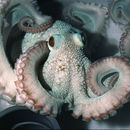en
names in breadcrumbs


Octopus briareus are interesting specimens of marine life. They can be easily studied and bred in laboratories, which allows scientists to continue to gain knowledge of them.
Octopus briareus are not in any danger so far due to humans. They are not sought after for any particular characteristics nor do they have any specific predators that are a major threat.
US Federal List: no special status
CITES: no special status
None. They are not particularly aggressive and their bites are not deadly.
None.
Octopus briareus eat a wide variety of animals, but their diet consists primarily of crabs and shrimp. Crabs are preferred because shrimp are much faster and more difficult to catch. Lobsters, polychaetes and a wide variety of fish are also consumed. Octopus briareus are known to hunt at dawn or dusk. They usually hunt by lying and waiting in their lairs, but if prey does not come around, they may leave to pursue it (Boyle 1983)
Octopus briareus are found in relatively warm, shallow water, including the tropical waters of the western Atlantic, the southeastern U.S., the Bahamas, the Caribbean islands, northern South America, and western Central America (Nauen 1984).
Biogeographic Regions: nearctic (Native ); neotropical (Native ); oceanic islands (Native ); atlantic ocean (Native )
They inhabit shallow waters around coral reefs as well as well as rocks and seagrass beds. They are usually hidden in their lairs, which are very difficult to locate. The lairs can be within a coral reef or among plants and rocks on the ocean floor. These lairs are in the relatively shallow waters of the littoral zone of the oceans (Nauen 1984).
Aquatic Biomes: benthic ; reef ; coastal
Octopus briareus have chunky bodies with eight arms that vary in length and diameter. In comparison to their bodies, their arms are relatively thin. They are able to change colors and textures in order to blend in to their surroundings. They can be brownish and even iridescent red to green. They do not demonstrate much sexual dimorphism. Males and females are similar in size, color, and demeanor. Also, the ovaries and testies are hidden. The only real noticeable differences are the presence of hectocotylus in males. This is a ventral crest formed by the fusion of a protective membrane with a ventral row of papillae so that the original form of conical papillae is hidden. Males also have at least one suction disc that is much larger than the rest as well and whiter in color. Octopus briareus are usually between 40cm and 60cm long, though they can get up to 100cm long. They can get up to 1.5kg in weight (Boyle 1983).
Range mass: 0 to 1.5 kg.
Average mass: 0 kg.
Other Physical Features: ectothermic ; bilateral symmetry
When it is time to mate, the male initiates the process. This usually happens during the day. He approaches the female, mounts her, perches on top of the mantle, and wraps his arms around her head and mantle. He then transfers two spermatophores with the hectocotylus into the oviduct. This process lasts between 30 and 80 minutes. Though the female may struggle, the male is the one that terminates the process when he swims away. Suction marks present on the female's mantle are evidence of mating. After they have sperm in their Females can store sperm in their oviducts for up to 100 days. Before they lay their eggs, they find a suitable site that will provide protection. They sometimes even close themselves inside their lair and seal off the opening. Females contain 100-500 eggs. The eggs are 10-14mm long and 4-5mm wide with a 5-10mm long stalk. These stalks hold together clusters of eggs, each made up of around 25 eggs. The female sits with her eggs and broods them until they are ready to hatch. The process takes 50-80 days for the eggs to mature enough to hatch; however, it can be much faster in warmer waters. When they emerge, the babies are small versions of adults and are able to swim, consume food, produce ink, and change color as soon as they are born. Growth is very quick, and after 17 weeks, young will be 75% of adult size. Males are sexually mature after just 140 days and females at 150 days (Boyle 1983).